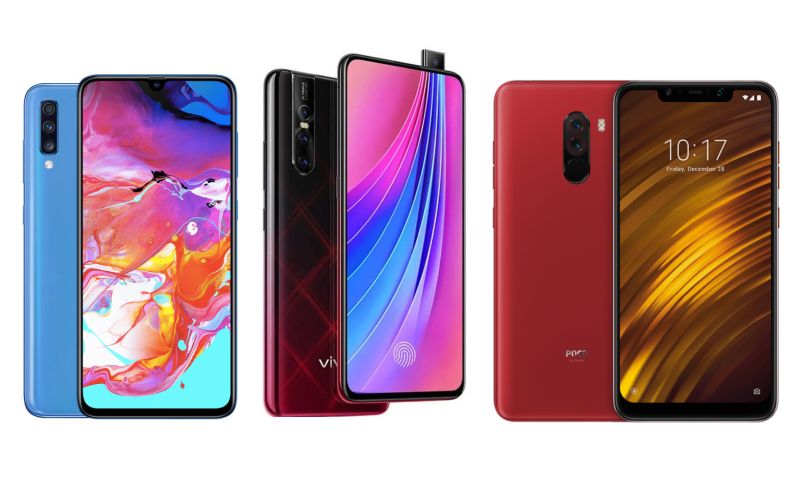The Galaxy A70 is the latest offering from Samsung in its revamped Galaxy A series. The smartphone is expected to come to India in a few days. It is an upper mid-range smartphone that comes with an in-display fingerprint sensor. Considering the price that Samsung has set for the Galaxy A70, the smartphone competes with the Vivo V15 Pro, which also bears a similar price and also offers an in-display fingerprint sensor. The Vivo V15 Pro takes things up a notch with its motorized pop-up selfie camera that allows the device to have an edge-to-edge display. Nevertheless, when there is a smartphone like Poco F1 in the market, which offers flagship performance at a relatively lesser price, it begs the question if the Samsung Galaxy A70 and Vivo V15 Pro are really worth it? Today, we will try to answer that question so you can make the right choice when buying any of the three smartphones.
Price
Both the Galaxy A70 and Vivo V15 Pro cost ₹28,990 for the 6GB RAM and 128GB storage variants. Poco F1, on the other hand, the same RAM/storage configuration at ₹21,999. There is also a cheaper variant with 6GB of RAM and 64GB of onboard storage with a price tag of ₹19,999. For ₹28,999, you can obtain the 8GB RAM and 256GB onboard storage variant of the Poco F1. Clearly, in terms of price, Poco F1 takes the lead by offering more for a relatively lesser price.
Design, Build
In terms of design, both Galaxy A70 and Vivo V15 Pro come with a premium build with an in-display fingerprint sensor. While Poco comes with a plastic body that is not as aesthetically appealing as its competitor, it does come with a traditional rear-mounted capacitive fingerprint sensor, that has been proven to be faster and more secure. The overall look and feel of the phone, however, is where Poco F1 lags behind. Samsung Galaxy A70 and Vivo V15 Pro offer a high-end design with a range of color options that looks and feels premium.
Vivo V15 Pro also manages to cram an innovative piece of technology i.e, pop-up selfie camera, which gives the smartphone a flagship-like feel. The Galaxy A70 comes with glossy back design. Lastly, the Poco F1 offers more of industrial design.
Display
With the help of its pop-up selfie camera, the Vivo V15 Pro manages to put out a seamless edge-to-edge 6.39-inch, Full HD+ AMOLED display. The Galaxy A70 comes with 6.7-inch AMOLED display with a waterdrop notch. Poco F1, unfortunately, does not offer an AMOLED display and instead offers 6.18-inch IPS LCD display with a wide notch and a thick chin at the bottom.
Performance
In terms of performance, Poco F1 rips through its competitors with its flagship Qualcomm Snapdragon 845 processor. That does not mean that the Qualcomm Snapdragon 675 offered in Galaxy A70 and Vivo V15 Pro are bad by any means, but they lack the power that Poco F1 could offer during high-intensity gaming sessions and overall performance of the phone.
As for the software, all three smartphones run on Android 9.0 Pie with their own custom skin on top. Samsung offers its One UI, while Poco F1 and Vivo V15 Pro come with MIUI and FunTouch OS respectively. When it comes to UI, Samsung’s One UI is the most sorted skin among the three. Xiaomi’s MIUI has, at times and again, been subjected to criticism due to the bloatware that comes with the skin and the ads that Xiaomi runs through its skin. Vivo’s FunTouch OS is not exactly a great UI either as it has its own fair share of bloatware and unnecessary apps.
Camera
The Vivo V15 Pro manages to get an edge over its competitors with a triple camera module compromising of a 48-megapixel primary camera, 8-megapixel secondary camera, and a 5-megapixel depth sensor. At the front, the Vivo V15 Pro offers a 32-megapixel selfie shooter. Samsung Galaxy A70 is not that far either in the imaging department as it offers the exact same configuration as V15 Pro’s camera, except, with the Galaxy A70, the primary camera is 32-megapixel. The Poco F1 falls short here with its dual camera setup compromising of a 12-megapixel and a 5-megapixel lens. At the front, the Poco F1 has a 20-megapixel sensor with an f/2.0 lens.
The F1 has recently been updated to include 4K recording a 60fps, however, the image quality trade-off for such a niche does not seem worth it.
Battery life
The Galaxy A70 is able to provide the best battery backup with its massive 4,500mAh battery coupled with 25W fast charging support and USB type-C. The Poco F1 comes next with a 4000mAh battery with 18W fast charging support over USB type-C. Lastly, the Vivo V15 Pro comes with a 3,700mAh battery that does support 18W charging but over the outdated micro-USB standard.
Verdict
The Poco F1, despite being older than its competitors, offers a bang for your bucks. Except for aesthetics and imaging, the Poco F1 offers a reasonable package that is ideal for power users. If you are not a gaming enthusiast and performance of the smartphone is secondary to you, the Galaxy A70 seems the right option. For users, who want innovative and a fresh take on a smartphone can opt for the Vivo V15 Pro.
ALSO READ:
- Asus Zenfone Max M1, Zenfone Lite L1 get a price cut, now start at ₹6,999 and ₹4,999 respectively
- 2019 iPhones could come with upgraded selfie camera
- Samsung Galaxy S10’s camera to get dedicated low-light camera mode

